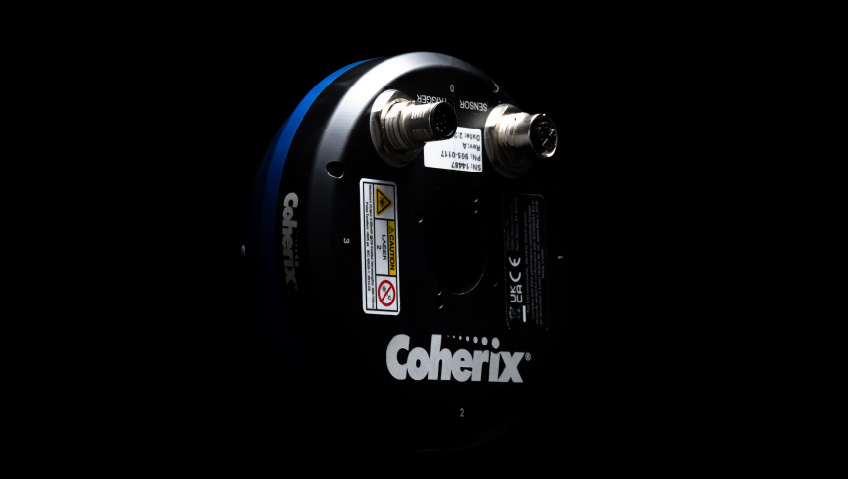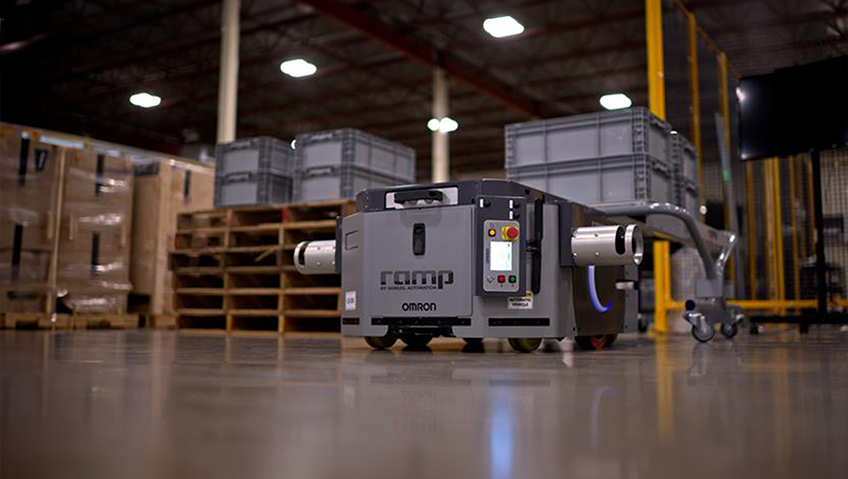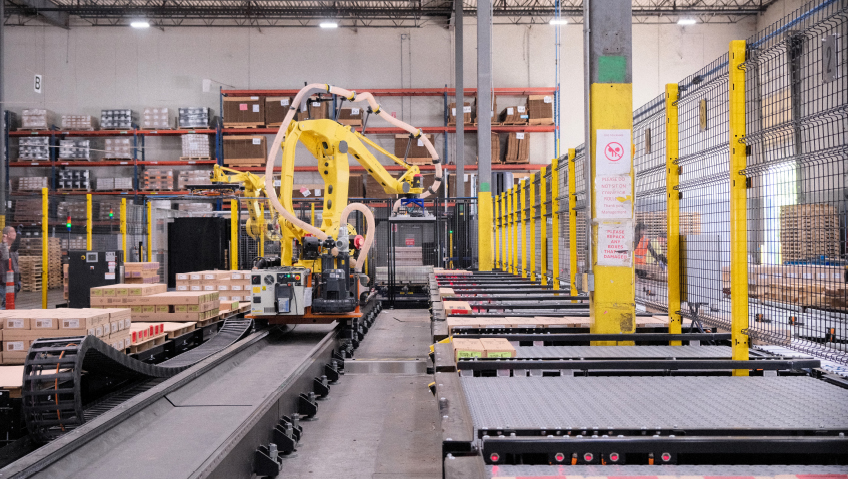The core of any operation is and has always been the conveyor, something Richards-Wilcox Conveyor knows all too well.
With more than a century of experience and expertise, the company continually evolves and expands, guiding clients into the future by designing the most efficient, intelligent, effective, dependable, and flexible conveyor solutions available, even after several generations and two industrial revolutions.
“Richards-Wilcox has a great history,” says President Bob McMurtry. “We were founded in 1880, and have been manufacturing for 144 years here in Aurora, Illinois, in the same location.”
Space for innovation
Now housed in a 365,000-square-foot factory, the company has continually evolved through a variety of different products, processes, and markets over the years, including pioneering overhead material-handling and inverted type conveyors which allow the movement of everything from raw materials to finished goods.
In 1922, the General Motors Truck Company of Pontiac, Michigan, implemented a Richards-Wilcox OveR-Way conveyor and, according to Mr. C. N. Wilt, Superintendent of the plant, the development “reduced floor space by 50 percent and increased productivity, saving cost and overhead. That’s still the message to this day: our automated material handling systems save companies floor space and labor dollars, and improve productivity and efficiency throughout their operations,” says McMurtry.
From bananas to engine blocks
The company offers several different overhead and inverted type conveyors depending on the customer’s application and process. “We match the conveyor system to the customer’s needs for moving material through its operations and the weight capacity of what is being moved. The applications using our material handling conveyors are diverse and have evolved over the years. We focus more on the weight of the product than the application,” says Matt Chorski, Sr. Conveyor Systems Sales Manager. He notes that generally, “our product weight limit is up to 3,000 pounds.”
Richards-Wilcox conveyor applications include a broad range of manufacturing systems and warehouse distribution systems. For example, Richards-Wilcox conveyor systems integrate automated material handling into assembly, fabrication, and finishing processes—moving products from engine blocks, tires, doors, boats, trailers, and custom fabrications to name just a few. “Our conveyors are also used in a variety of warehouse distribution centers—moving anything from produce, such as bananas or grapefruit, to packages at the major ecommerce carrier facilities,” says Chorski.
“A particular focus of the company’s applications includes various finishing operations in a manufacturing process, such as painting—using liquid paint, powder coat paint, or plating—in multiple applications in the automotive industry—everything from plastic bumpers to engine blocks,” according to Chorski. “However, there is no limitation to our conveyor applications. Our conveyors, both overhead and inverted, have been deployed to make everything from solar panels to tires, residential and commercial doors, automotive and truck parts—the list goes on and on.
“It’s a testament to the innovation the company lives by,” McMurtry says. “We’ve been manufacturing for over 144 years and we’ve launched lots of new products and there are things we no longer make. To do that, you have to innovate and evolve and be responsive to the marketplace.”
Richard-Wilcox’s innovation over the years has taken several different avenues, from simple mechanical engineering and solution-providing to the special and unique. “Our focus is finding the most efficient and productive solution. We routinely save customers floor space and reduce labor costs by designing solutions that address the process in the factory rather than somebody’s linear idea of what’s supposed to happen,” says McMurtry.
For example, the company can process parts through a washer, a paint line, or a process, and then accumulate and stop those parts in an oven or dryer, allowing them to go through a time-based process where they need to reach a certain temperature or cure for a certain amount of time. There is rotation capability, allowing for the accumulation of more parts in a smaller footprint and switching speeds from a slower process speed to a faster speed in the load-unload areas where the operators can interface with parts at stops.
“Those are the kinds of mechanical things we innovate with our conveyors,” says Chorski. “We have the ability to go up and down and around curves, and maintain the part orientation as it goes through elevations or rotations.”
Data feedback
Industry 4.0 is another key area of innovation, says Chorski, an approach that is largely about feedback—knowing where everything is all the time, and knowing the status of equipment.
Richards-Wilcox’s control technology integrates Industry 4.0 principles, which include sensor technology that provides active feedback, allowing a control system or a larger MES system to know exactly what’s happening in the factory at all times. Other elements of Industry 4.0 might include RFID or metal barcode scanning that allows tracking of individual parts throughout the system.
“Throughout the manufacturing process, whether it be painting or assembly, we also have a full integration suite with robotics,” Chorski explains. “A lot of what we’re seeing is assembly robots and painting robots and we offer full integration with both linear and six-axis robots. This is so our Industry 4.0 control technology can provide feedback to other automation devices within a factory to identify the part orientation and the presence of the parts,” he says. “In this way, an assembly process or a painting process is integrated with other robots in the system for 100 percent part conformation.”
High-level material handling
Part of the evolution of the company’s conveyor systems is integration with other systems and with control technology that allows somewhat routine material handling to be integrated with state-of-the-art control systems and process technologies.
Richards-Wilcox also regularly deals with clients looking for the new and the innovative, pushing the company to utilize its creativity and innovative ability. “Every day we get applications that are new and different, as well as applications that we’ve done in the past,” McMurtry says.
Using its innovative technology, Richards-Wilcox can do what the client asks for, McMurtry explains—but can offer alternate solutions that will improve the overall system and save on the floor space required.
“That’s kind of the thing that we look at. We want to provide a complete solution that benefits the customer and saves them money,” McMurtry says. “We know conveyor systems are large capital expenditures; they’re big commitments. So if we can help the customer save floor space, save money in equipment that’s being integrated into the conveyor system, and save on labor, it helps justify that return on investment.”
Changing when things change
The evolution of industry—and the evolution of the innovation of industry—McMurtry adds, is about automation and flexibility. One of the challenges automation brings is that, while it’s easy to automate just the one product that you’ll repeat a million times a year, “what’s challenging is when you have a multitude of products and, what’s more, products that have to change. One of the things our system is capable of doing is being flexible enough to address a manufacturing process that requires flexibility.”
In the automotive industry, you make the same part for maybe five years at high volume, and then they move on to the next platform, with a product you might not have the capability to create. “If you’ve sunk millions of dollars into a process and a conveyor system, you don’t want to have to completely replace that every five years. You want it to be flexible so that it can change for the next process or the next product line. And that’s true in distribution centers as well.”
So the key to industry evolution, McMurtry reiterates, is designing solutions that are flexible and will evolve with the company’s operations without ever losing productivity.
“One of our value propositions is the particular expertise we have to deliver custom solutions and flexible solutions that will enable our end users to change with changing market demands,” he says. “And that’s a big challenge for everybody—something that needs to be kept in mind as you move forward with solutions.”
Another big challenge for manufacturing, and the economy in general, is the labor market, he adds. Currently, much effort is being expended to create interest in manufacturing jobs and vocational study programs, but that has not been the case for the last 20 years and, consequently, it will take some time to rebuild the necessary infrastructure.
Richards-Wilcox, however, will continue to utilize the knowledge and skills it has honed for decades on its own products.
Needs of the marketplace
“We’re constantly looking to innovate and develop new products in each of our product lines, conveyor being one of them,” Chorski says. “We want to be a leader in the industry and we want to stay at the forefront like we have for 100 years and develop solutions we and our customers perceive the need for. We want to look for that next-generation problem or next-generation solution that we can offer our customers, maybe before they even think of it.”
Ultimately, it’s what helps set the company apart—that long history and wealth of knowledge in providing solutions, and also the long history of innovation and new product development.
“It’s quite a legacy. When we’re out at trade shows or talking to people, the Richards-Wilcox conveyor brand is really well known,” McMurtry says. “It represents quality, durability, and innovation, and has been known for literally a hundred years for being the highest quality and the most durable system out there.”
That innovation is still going on with the introduction just this year of a fully stainless steel chain and stainless steel track for its conveyor, allowing full stainless steel conveyor systems or a portion of the system in full stainless, which is innovative. In fact, the company is the only one in the marketplace with this kind of stainless steel chain—the heart of the conveyor system—which is the most durable and longest-lasting chain on the market.
It’s this kind of evolution that keeps Richards-Wilcox on the cutting edge of a constantly moving industry, keeping awareness of the client’s needs always at the forefront of everything it does.
“Use is limited only by what the customer needs to move and whether it fits within our weight limit,” says Chorski. “That’s one of the distinguishing things about Richards-Wilcox—the extensive knowledge of material handling and automated conveying of material, and our vast experience over 100 years of satisfying industry’s challenges.”






